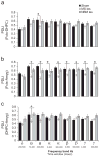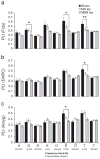Cholinergic modulation of event-related oscillations (ERO)
- PMID: 24594019
- PMCID: PMC4090032
- DOI: 10.1016/j.brainres.2014.02.043
Cholinergic modulation of event-related oscillations (ERO)
Abstract
The cholinergic system in the brain modulates patterns of activity involved in general arousal, attention processing, memory and consciousness. In the present study we determined the effects of selective cholinergic lesions of the medial septum area (MS) or nucleus basalis magnocellularis (NBM) on amplitude and phase characteristics of event related oscillations (EROs). A time-frequency based representation was used to determine ERO energy, phase synchronization across trials, recorded within a structure (phase lock index, PLI), and phase synchronization across trials, recorded between brain structures (phase difference lock index, PDLI), in the frontal cortex (Fctx), dorsal hippocampus (DHPC) and central amygdala (Amyg). Lesions in MS produced: (1) decreases in ERO energy in delta, theta, alpha, beta and gamma frequencies in Amyg, (2) reductions in gamma ERO energy and PLI in Fctx, (3) decreases in PDLI between the Fctx-Amyg in the theta, alpha, beta and gamma frequencies, and (4) decreases in PDLI between the DHPC-Amyg and Fctx-DHPC in the theta frequency bands. Lesions in NBM resulted in: (1) increased ERO energy in delta and theta frequency bands in Fctx, (2) reduced gamma ERO energy in Fctx and Amyg, (3) reductions in PLI in the theta, beta and gamma frequency ranges in Fctx, (4) reductions in gamma PLI in DHPC and (5) reduced beta PLI in Amyg. These studies suggest that the MS cholinergic system can alter phase synchronization between brain areas whereas the NBM cholinergic system modifies phase synchronization/phase resetting within a brain area.
Keywords: Cholinergic system; Electroencephalogram; Event related oscillation; Event-related potential; Phase difference lock index; Phase lock index.
Copyright © 2014 Elsevier B.V. All rights reserved.
Conflict of interest statement
Dr. Ehlers work has been funded by the NIH. She has received compensation as a consultant from Neurocrine Biosciences and Raptor Pharmaceutical Corp. in capacities not related to the subject of the report. Dr. Manuel Sanchez-Alavez, Dr. Patricia Robledo Dr. Jim Havstad and Derek Wills declare no potential conflicts of interest.
Figures






References
-
- Amaral DG, Kurz J. An analysis of the origins of the cholinergic and noncholinergic septal projections to the hippocampal formation of the rat 240, 37–59J. Comp Neurol. 1985;240:37–59. - PubMed
-
- Basar-Eroglu C, Basar E, Schmielau F. P300 in freely moving cats with intracranial electrodes. Int J Neurosci. 1991;60:215–226. - PubMed
-
- Basar E. A review of gamma oscillations in healthy subjects and in cognitive impairment. Int J Psychophysiol. 2013;90:99–117. - PubMed
Publication types
MeSH terms
Substances
Grants and funding
LinkOut - more resources
Full Text Sources
Other Literature Sources
Miscellaneous

